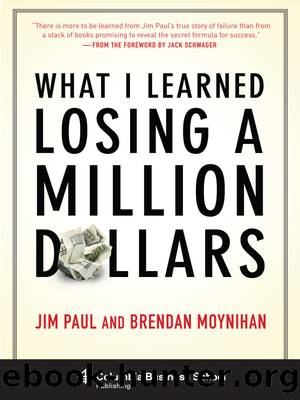What I Learned Losing a Million Dollars by Jim Paul

Author:Jim Paul
Language: eng
Format: epub
Tags: BUS019000, Business & Economics/Decision-Making & Problem Solving, BUS036060, Business & Economics/Investments & Securities / Stocks
Publisher: Columbia University Press
Published: 2013-04-22T16:00:00+00:00
DISCRETE EVENTS VS. CONTINUOUS PROCESSES
Earlier in the chapter we saw that someone could actually internalize an external loss; the player or spectator could take the loss of the game as a personal matter and internalize what is properly an external loss. Although someone could do it, it’s a little hard to imagine someone going through the stages of denial, anger, bargaining, depression, and acceptance over a basketball game. Why? Because the game is a discrete event—an activity with a defined ending point. However, internalizing an external loss is a lot easier to do with the other type of loss-producing activity: a continuous process—an activity that has no clearly defined end. Losses from continuous processes are much more prone to become internalized because, like all internal losses, there is no predetermined ending point.
In a continuous process, the participant gets to continuously make and remake decisions that can affect how much money he makes or loses. On the other hand, a discrete event (e.g., a football game, roulette, blackjack, or other casino game) has a defined ending point, which is characteristic of external losses. A loss resulting from a discrete event is definitive and not open to interpretation. When I bet on a Kentucky basketball game and Kentucky loses, it is a discrete event and an external loss that I can’t really argue with. Or, if I bet on 21 red in roulette and the ball lands on 17 black, I lost—period.
The markets fall into the category of continuous process because market positions have no predetermined ending point. Granted, the market has a defined open and close for the day, but a market position continues beyond the market’s close and could go on forever. Even though a loss in the market is an external loss (since money is external, not internal), it is also the result of a continuous process and prone to becoming an internal loss. Why? In a continuous process there is no certainty of how or when the open market position will end. That uncertainty about the future triggers the Five Stages of Internal Loss, which means the loss has become internalized, personalized, and subjective. Because a losing market position is a continuous process, nothing forces you to acknowledge it as a loss; there’s just you, your money, and the market as a silent thief. So as long as your money holds out, you can continue to kid yourself that the position is a winner that just hasn’t gone your way yet. The position may be losing money, but you tell yourself it’s not a loss because you haven’t closed the position yet. This is especially true for stock-market positions because when you own the stock outright, no margin call is going to force you to call a loss a loss.
Think of the differences between discrete events and continuous processes this way: Would you lose more money or less money at the racetrack if they stopped the race in the middle and reopened the betting window? That is to
Download
This site does not store any files on its server. We only index and link to content provided by other sites. Please contact the content providers to delete copyright contents if any and email us, we'll remove relevant links or contents immediately.
Hit Refresh by Satya Nadella(8338)
When Breath Becomes Air by Paul Kalanithi(7264)
The Girl Without a Voice by Casey Watson(7263)
Do No Harm Stories of Life, Death and Brain Surgery by Henry Marsh(6337)
A Court of Wings and Ruin by Sarah J. Maas(6079)
Hunger by Roxane Gay(4219)
Shoe Dog by Phil Knight(4169)
Everything Happens for a Reason by Kate Bowler(4067)
A Higher Loyalty: Truth, Lies, and Leadership by James Comey(4033)
The Rules Do Not Apply by Ariel Levy(3906)
Tuesdays with Morrie by Mitch Albom(3832)
The Immortal Life of Henrietta Lacks by Rebecca Skloot(3826)
How to Change Your Mind by Michael Pollan(3679)
Millionaire: The Philanderer, Gambler, and Duelist Who Invented Modern Finance by Janet Gleeson(3569)
All Creatures Great and Small by James Herriot(3517)
Elon Musk by Ashlee Vance(3455)
Tokyo Vice: An American Reporter on the Police Beat in Japan by Jake Adelstein(3440)
Man and His Symbols by Carl Gustav Jung(3315)
The Money Culture by Michael Lewis(3284)
